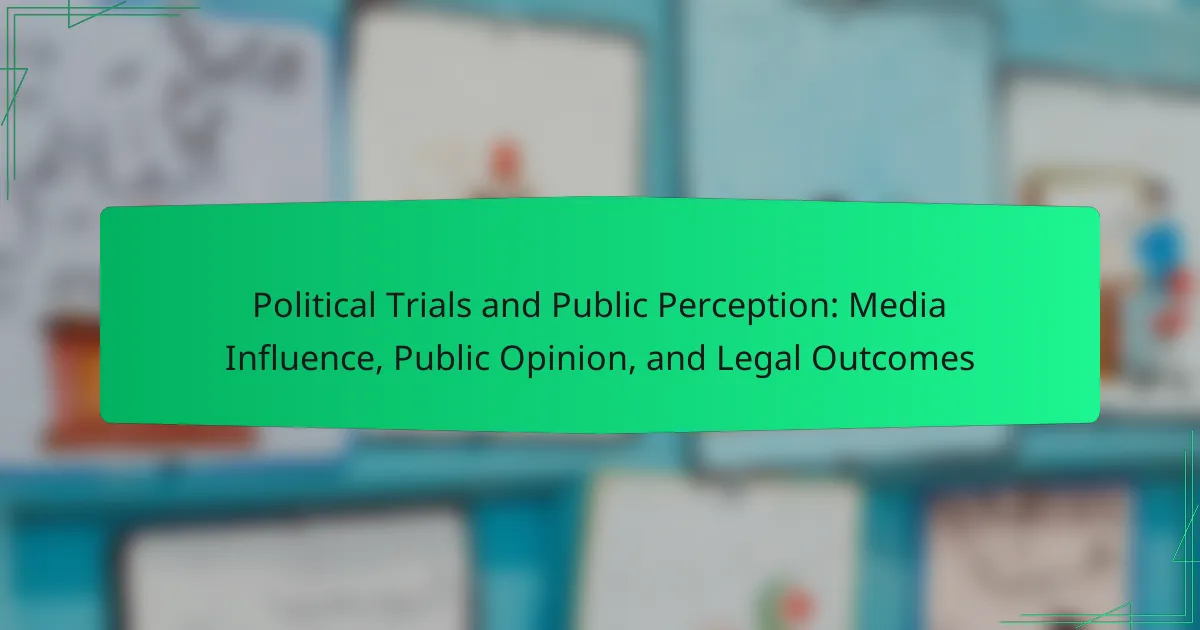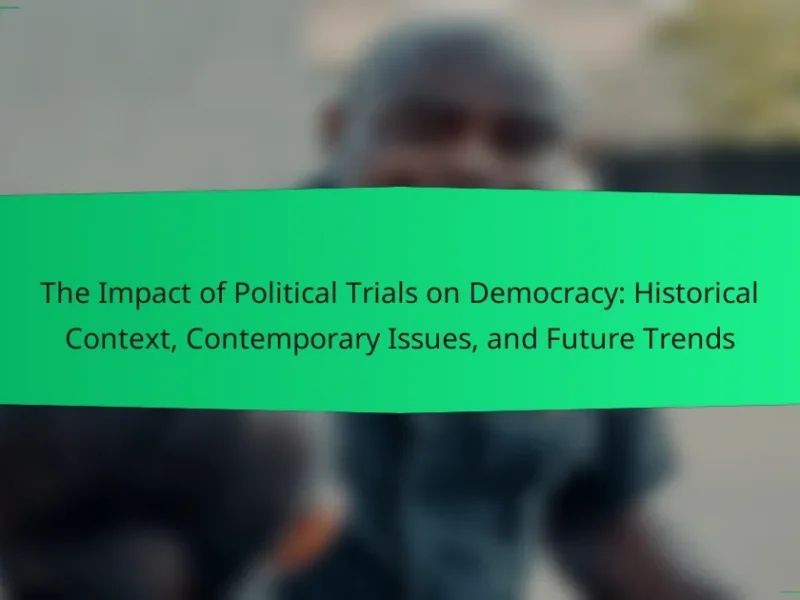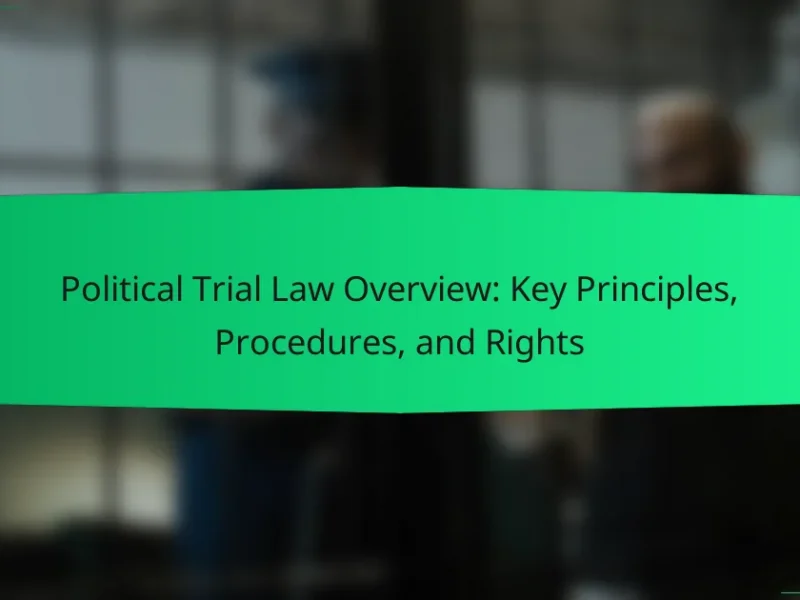Political trials are legal proceedings involving government officials or political figures charged with offenses related to their public duties. This article examines the significant impact of media coverage and public opinion on the outcomes of these trials. It discusses how media narratives shape perceptions of political figures, often leading to polarized views and influencing juror decisions. High-profile cases, such as the impeachment of President Bill Clinton, illustrate the interplay between media scrutiny and public sentiment, which can pressure legal authorities and affect judicial outcomes. The relationship between media portrayal, public opinion, and legal proceedings highlights the broader implications for justice and accountability in political contexts.
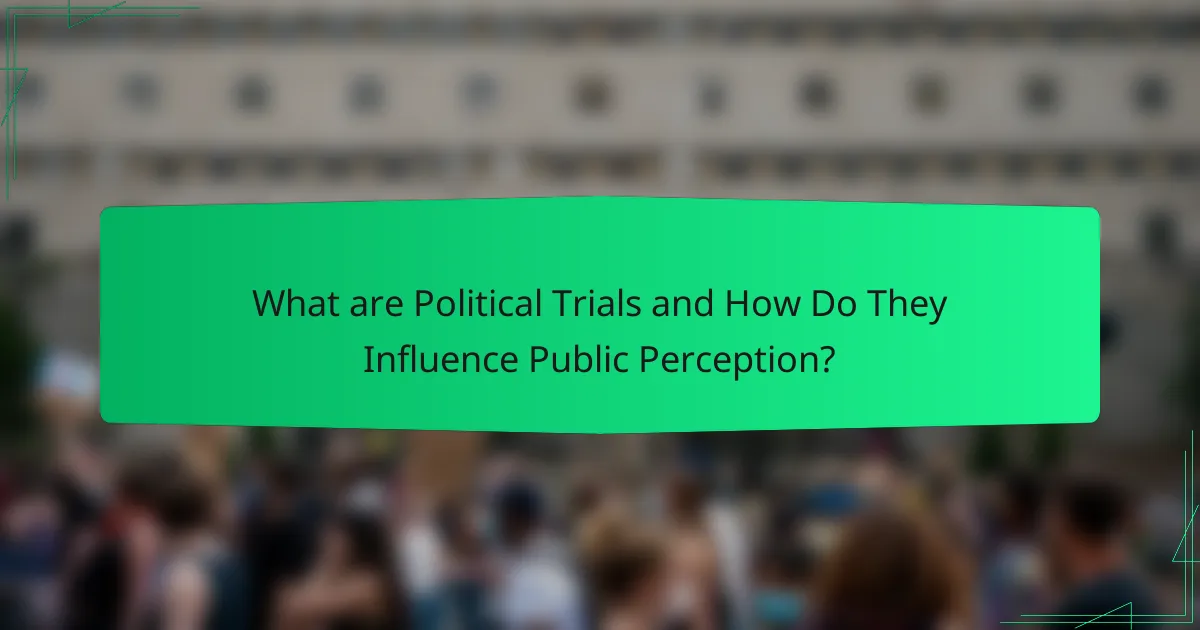
What are Political Trials and How Do They Influence Public Perception?
Political trials are legal proceedings that involve government officials or political figures, often charged with offenses related to their public duties. These trials can significantly influence public perception by shaping opinions about the political figures involved. Media coverage plays a crucial role in this process, as it can highlight specific narratives and frame the context of the trial. For example, high-profile political trials, such as the impeachment of President Bill Clinton, garnered extensive media attention, which swayed public opinion. Research indicates that media portrayal can lead to polarized perceptions, affecting trust in institutions. Additionally, political trials can evoke emotional responses from the public, further impacting their views on justice and accountability. The outcomes of these trials often resonate beyond the courtroom, influencing future political dynamics and public discourse.
How do political trials shape media narratives?
Political trials significantly shape media narratives by influencing public perception and framing legal issues. Media coverage often highlights sensational aspects of the trials. This can lead to polarized opinions among the public. For instance, the trial of former President Donald Trump in 2023 generated extensive media discourse. Coverage focused on allegations, courtroom drama, and political implications. Such narratives can affect voter sentiment and engagement. Research indicates that media framing can sway public opinion, as seen in the coverage of the Watergate scandal. This illustrates how political trials can become pivotal moments in media history.
What role does the media play in framing political trials?
The media plays a crucial role in framing political trials by shaping public perception and influencing opinions. Through selective reporting, the media highlights specific aspects of trials, which can affect how audiences interpret events. For instance, the portrayal of defendants can lead to biases, impacting juror opinions and public sentiment. Research indicates that media coverage often emphasizes sensational elements, which can skew the narrative. According to a study by the Pew Research Center, 66% of Americans believe that media coverage influences public perception of legal cases. This demonstrates the media’s significant power in framing political trials and their outcomes.
How do sensationalized media reports affect public opinion?
Sensationalized media reports significantly shape public opinion by amplifying emotions and biases. These reports often prioritize dramatic narratives over factual accuracy. For example, studies show that sensational headlines can lead to increased fear and mistrust among the public. Research by the Pew Research Center indicates that sensationalized coverage can distort perceptions of crime rates and social issues. This distortion occurs because sensationalism tends to focus on rare events while neglecting broader context. As a result, audiences may develop skewed views based on exaggerated claims. Furthermore, sensationalized reporting can create a sense of urgency, influencing public reactions and policy discussions.
Why is public perception critical in political trials?
Public perception is critical in political trials because it can influence the outcomes of legal proceedings. High-profile cases often attract significant media attention, shaping public opinions. Positive or negative perceptions can pressure legal authorities and impact jury decisions. For instance, in the case of the impeachment trial of President Bill Clinton, public opinion played a substantial role in shaping the political landscape. Polls indicated that public sentiment was divided, affecting lawmakers’ actions. Ultimately, political trials are not just about legal facts; they are also about how those facts are perceived by the public.
How does public opinion impact the outcomes of political trials?
Public opinion significantly impacts the outcomes of political trials. It shapes juror perceptions and influences the legal process. High-profile cases often see media coverage that sways public sentiment. Positive or negative public opinion can pressure legal authorities to act in specific ways. For example, public outcry can lead to heightened scrutiny of trial proceedings. Conversely, favorable public opinion can bolster defense strategies. Historical instances, such as the trial of O.J. Simpson, illustrate how media portrayal affected jury dynamics. Studies show that jurors are not immune to societal pressures. Public sentiment can ultimately affect verdicts and sentencing decisions in political trials.
What factors contribute to shifts in public perception during trials?
Factors that contribute to shifts in public perception during trials include media coverage, public opinion polls, and the behavior of trial participants. Media coverage can shape narratives and highlight specific aspects of the trial. For example, sensational reporting can sway public emotions and opinions. Public opinion polls provide insight into prevailing attitudes and can influence perceptions by reflecting majority views. The behavior of trial participants, such as attorneys and witnesses, can also affect public perception. Engaging and credible testimonies may lead to increased public sympathy or support for a party involved. Historical examples, like the O.J. Simpson trial, illustrate how these factors can significantly alter public perception over time.
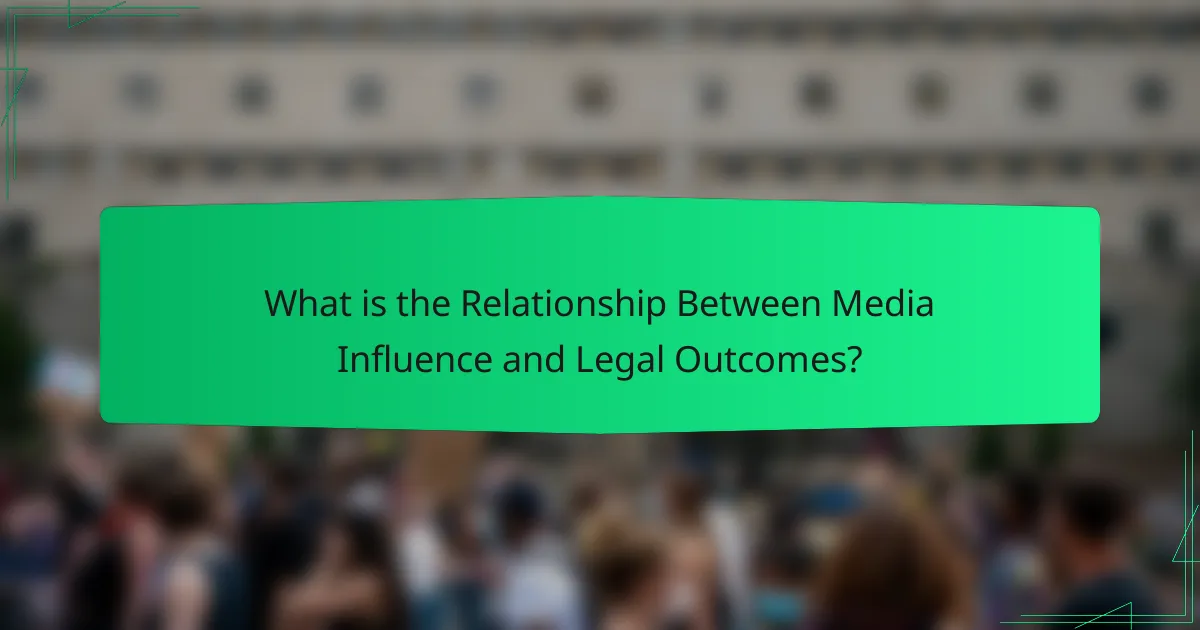
What is the Relationship Between Media Influence and Legal Outcomes?
Media influence significantly impacts legal outcomes. This relationship is evident through the shaping of public opinion. Media coverage can sway jurors and affect trial proceedings. High-profile cases often receive intense media scrutiny. This scrutiny can create biases among jurors. Studies show that pre-trial publicity influences verdicts. For example, a study by the American Psychological Association found that jurors exposed to media coverage are more likely to be influenced by that information. Additionally, sensationalized reporting can lead to public pressure on legal systems. This pressure may result in harsher sentences or altered charges. Overall, the media plays a crucial role in shaping the context of legal proceedings.
How do media portrayals affect the judicial process?
Media portrayals significantly influence the judicial process by shaping public opinion and perceptions of justice. These portrayals can create biases that affect jury selection and trial outcomes. Research indicates that sensationalized coverage can lead to preconceived notions about guilt or innocence. For example, a study by the American Bar Association found that media narratives often skew public perception, impacting the fairness of trials. Furthermore, extensive media coverage can pressure legal entities to act in alignment with public sentiment. This dynamic can lead to a trial by media, where the public forms opinions before evidence is presented in court. Consequently, media portrayals can undermine the integrity of the judicial process.
What are the potential biases introduced by media coverage?
Media coverage can introduce several potential biases that affect public perception. One significant bias is selection bias, where certain stories are chosen over others, shaping the narrative. This can lead to an unbalanced portrayal of events. Another bias is framing bias, which involves the way information is presented. This can influence how audiences interpret the significance of the news. Additionally, confirmation bias may occur when media outlets favor information that aligns with their existing viewpoints. This reinforces pre-existing beliefs among audiences. Furthermore, sensationalism can skew public perception by emphasizing dramatic aspects over factual reporting. Studies have shown that these biases can impact public opinion significantly, especially in politically charged cases. For example, research from the Pew Research Center indicates that media framing can alter perceptions of political figures during trials.
How can media influence juror decisions in political trials?
Media can significantly influence juror decisions in political trials through exposure to information, framing, and public opinion. Jurors may be swayed by the narratives presented in news coverage. This can lead to preconceived notions about the case or the defendant. Research indicates that jurors often rely on media portrayals when forming their opinions. A study by the American Bar Association found that jurors exposed to biased media coverage are more likely to make decisions based on that information. Furthermore, sensationalist reporting can create a perception of guilt before evidence is even presented in court. This impact underscores the importance of media literacy among jurors. Ultimately, the media’s role in shaping public perception can directly affect legal outcomes in high-profile political trials.
What are the implications of media influence on legal outcomes?
Media influence can significantly shape legal outcomes by affecting public perception and jury decisions. High-profile cases often receive extensive media coverage. This coverage can create biases, swaying public opinion before a trial begins. Jurors exposed to media narratives may enter the courtroom with preconceived notions. Research indicates that jurors are influenced by pretrial publicity. Studies show that negative media portrayals can lead to harsher judgments. Conversely, positive media framing may result in more lenient verdicts. The implications extend to the integrity of the judicial process. Ultimately, media influence raises concerns about fair trials and justice.
How do legal professionals respond to media narratives?
Legal professionals respond to media narratives by actively engaging with the public discourse. They may issue statements to clarify legal positions or correct misinformation. This engagement helps shape public understanding of legal issues. Legal professionals also monitor media coverage to assess its impact on public opinion. They may adjust their strategies based on how narratives are portrayed. Studies show that media representation can influence jury perceptions and trial outcomes. For instance, research indicates that negative media coverage can bias jurors against defendants. Thus, legal professionals prioritize managing media narratives to protect their clients’ interests.
What measures can be taken to mitigate media bias in trials?
Implementing guidelines for media reporting can mitigate bias in trials. Establishing a code of ethics for journalists is essential. This code should emphasize accuracy and fairness in reporting. Providing training for journalists on legal proceedings can enhance their understanding. Encouraging balanced coverage by including multiple perspectives is crucial. Utilizing fact-checking resources can help ensure the accuracy of reported information. Limiting access to sensitive information during ongoing trials can reduce sensationalism. Engaging legal experts in media discussions can improve public understanding of complex issues. These measures collectively contribute to a more informed public and fairer trial processes.
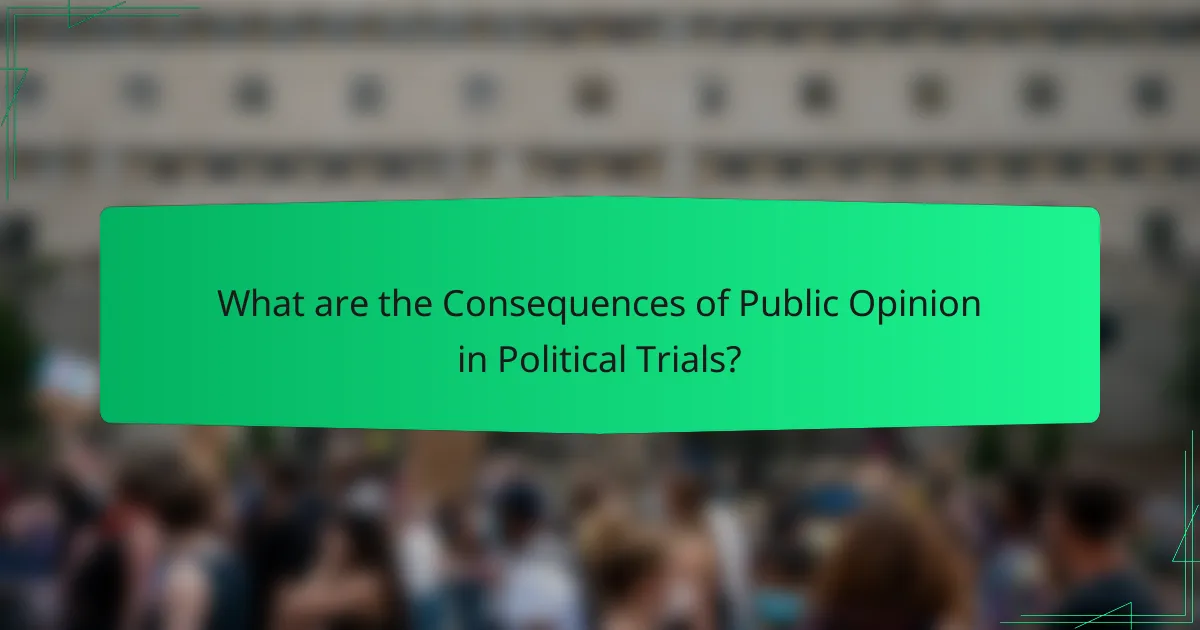
What are the Consequences of Public Opinion in Political Trials?
Public opinion significantly influences the outcomes of political trials. It can sway juror perceptions and affect judicial decisions. High-profile cases often attract intense media scrutiny. This scrutiny shapes public sentiment, which can pressure legal authorities. For instance, in the trial of former President Bill Clinton, public opinion played a crucial role. Polls indicated that public support or opposition impacted the trial’s proceedings. Additionally, negative public perception can lead to calls for harsher penalties. Conversely, favorable public opinion may result in leniency. Overall, public opinion acts as a powerful force in shaping the dynamics of political trials.
How does public opinion shape political accountability?
Public opinion shapes political accountability by influencing the actions and decisions of elected officials. When the public expresses strong opinions on issues, politicians often feel pressured to respond accordingly. This pressure can manifest through voting patterns, protests, or public discourse. For example, a Gallup poll indicated that 75% of Americans believe that politicians should be held accountable for their actions. High-profile cases, such as the Watergate scandal, demonstrate how public scrutiny can lead to resignations and legal consequences for political leaders. Additionally, social media amplifies public opinion, allowing for rapid dissemination of views that can impact political narratives. Thus, public opinion serves as a critical mechanism for ensuring that political figures remain responsive to the electorate.
What are the long-term effects of political trials on public trust in institutions?
Political trials can significantly diminish public trust in institutions over the long term. These trials often create perceptions of bias and injustice. When institutions appear to be politically motivated, public confidence erodes. Historical examples, such as the impeachment trials in the United States, illustrate this trend. Polls show that trust in government institutions declines following high-profile political trials. This effect can persist for years, as seen in studies conducted by the Pew Research Center. The long-term consequences include increased skepticism toward political leaders and a disengaged electorate. Ultimately, political trials can lead to a lasting impact on the legitimacy of institutions.
How can political trials lead to social change?
Political trials can lead to social change by highlighting injustices and mobilizing public opinion. These trials often attract media attention, which amplifies their significance. High-profile cases, such as the trial of Nelson Mandela, showcased systemic oppression and inspired activism. They can serve as a catalyst for reform by exposing corruption and human rights violations. Public outrage from these trials can pressure governments to enact policy changes. Additionally, they can shift societal norms by framing issues in a new light. Historical examples demonstrate that political trials can redefine public discourse and influence legislation.
What strategies can be employed to manage public perception during trials?
Effective strategies to manage public perception during trials include proactive communication, media engagement, and transparency. Proactive communication involves issuing timely statements to clarify facts and counter misinformation. Engaging with media outlets helps shape narratives and provides platforms to present the entity’s perspective. Transparency about trial processes builds trust and mitigates speculation. Additionally, leveraging social media can facilitate direct interaction with the public. Research indicates that public perception significantly influences legal outcomes, making these strategies crucial. For example, a study by the Pew Research Center found that public opinion can sway jury decisions, emphasizing the need for careful management of perceptions during trials.
How can legal teams effectively communicate with the public?
Legal teams can effectively communicate with the public by utilizing clear messaging and engaging platforms. They should focus on transparency to build trust. Consistent updates on legal proceedings can keep the public informed. Using social media allows for direct interaction and feedback. Press releases can clarify complex legal issues in accessible language. Engaging with community events fosters a positive relationship. Additionally, legal teams should be prepared to address misinformation swiftly. This approach can enhance public understanding and support for legal processes.
What role does transparency play in shaping public opinion?
Transparency plays a crucial role in shaping public opinion. It fosters trust between the public and institutions. When information is readily available, individuals can form informed opinions. Transparency also reduces misinformation and speculation. Studies show that transparent communication increases public engagement. For example, during political trials, clear information can lead to a more balanced perception. Research by the Pew Research Center indicates that transparency enhances credibility. This credibility influences public trust and acceptance of legal outcomes.
What best practices can be adopted for navigating political trials and public perception?
Establishing clear communication is vital for navigating political trials and public perception. Consistent messaging helps maintain trust and credibility. Engaging with the media proactively can shape narratives positively. Transparency about the legal process reassures the public and mitigates speculation. Monitoring public sentiment through surveys aids in understanding perceptions. Building alliances with trusted community leaders enhances credibility. Utilizing social media effectively can counter misinformation swiftly. Ultimately, these practices can influence public opinion and legal outcomes significantly.
Political trials involve legal proceedings against government officials or political figures, significantly impacting public perception and the judicial process. This article examines how media coverage shapes narratives during such trials, influencing public opinion and juror decisions. Key topics include the role of sensationalism in media reporting, the relationship between public sentiment and legal outcomes, and strategies for managing public perception. The discussion highlights the long-term effects of political trials on trust in institutions and the potential for social change driven by public outrage and media attention.
